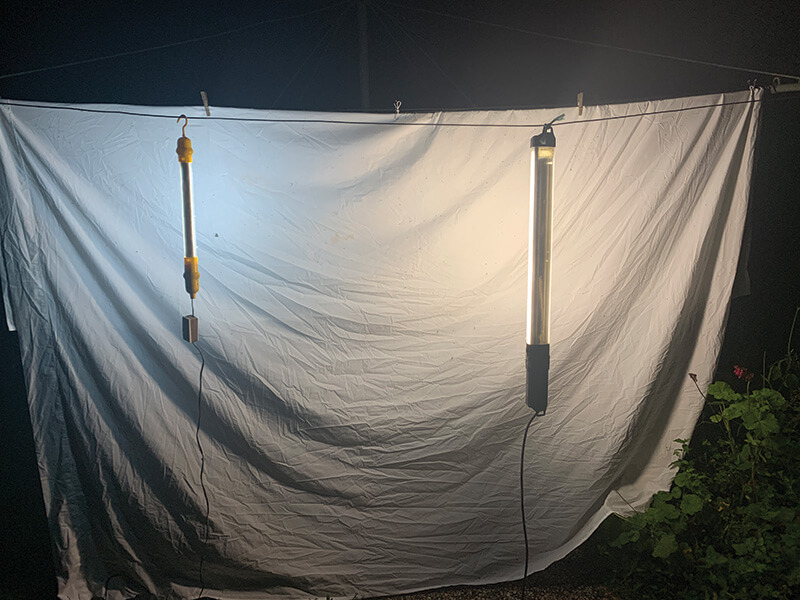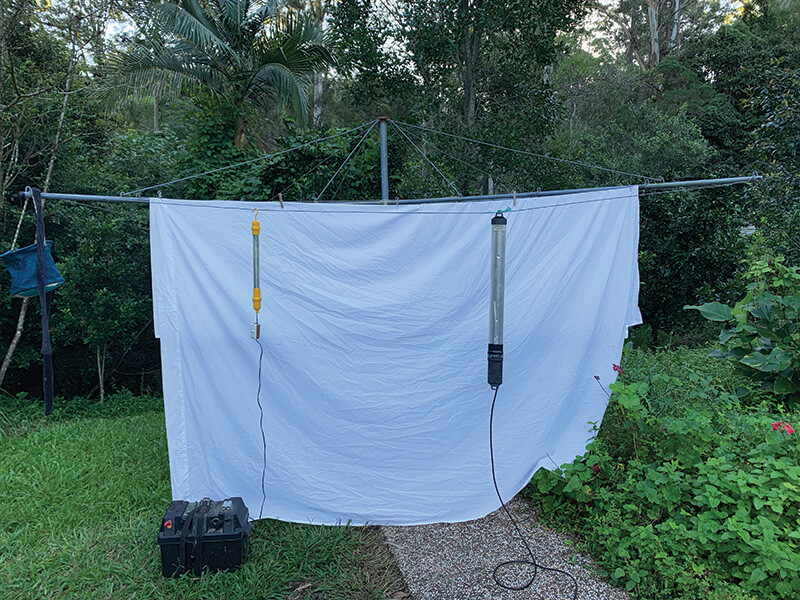Most moths are inactive and well-hidden during the day and only active at night, which means that if you wish to take a closer look at them you need to come up with some way of attracting them to a convenient observation spot. We can use their natural attraction to light to do just this. Interestingly, it is still a mystery exactly why moths and other nocturnal insects are attracted to lights.
A quick search of the internet for ‘How to make a light trap for moths?’ will yield a wide variety of trap designs from the cheap and simple through to complex and expensive setups that involve fabrication and electronics skills that are beyond me. There are also a few off-the-shelf traps for the more serious entomologists.
Probably the simplest way is to leave an outdoor light on. While any light will attract some moths, more will be attracted to an unshielded fluorescent tube or compact fluorescent light (CFL). Fluorescent lights work better than other light sources because they emit some light in the UV portions of the light spectrum. You will get even better results if the light is adjacent to a white wall but if you don’t have a white wall you can simulate one with a white bedsheet.
Now if this is not possible (or you don’t like the idea of a verandah covered in moths) you can take the bedsheet to the clothesline and use a portable work-light. If you don’t have a portable work light you can get them reasonably cheaply from your local hardware or auto store. Remember to get one that uses a fluorescent tube or CFL.
Light traps of this sort are usually attended, that is, you stand or sit nearby with your camera ready to photograph the moths that get attracted. I find the waiting is made easier by the addition of a small glass of single malt whisky, you may find other beverages helpful. Alternatively, the light can be left on all night and inspected just before you go to bed and again just after first light the next morning. If you leave it too late in the morning some moths will fly off and will become breakfast for the birds.


You can easily upgrade this setup by fabricating a portable frame for your white sheet from PVC pipe and changing your CFL bulb or fluorescent tube for one that emits more strongly in the UV portion of the light spectrum. These are called actinic or black lights and are available from entomology suppliers such as
www.entosupplies.com.au
A second kind of trap utilises a bucket or similar container with a light source over a funnel, these sorts of traps are designed to be portable and easily deployed in the field. This website from the UK shows various do-it-yourself bucket and funnel traps for moths – butterfly-conservation.org (search ‘moth trap’).
Many factors will affect how many moths are attracted to your trap, such as the kind of light source you have, moon phase, other light sources and weather factors like rain and temperature. For a thorough survey of your local moths, you will need to repeat your moth trapping regularly.
Finally, once you have ‘trapped’ your moths make sure you get some really clear photos using your smartphone or even better, a DSLR with a macro lens. Then upload them to iNaturalist where an active online community of moth experts can help identify your moths and contribute to a better understanding of Australia’s incredible moth diversity.
Australia’s incredible moth diversity.
Article and photos below by Alan Wynn
Land for Wildlife Officer
Sunshine Coast Council
